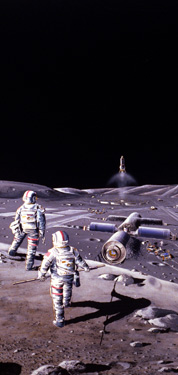May 20 2021
Space Weather and Moon Landings
 As project Artemis proceeds with plans not only to return to the Moon, but to produce the infrastructure for a long term presence, we need to deal with the issue of solar storms. If you haven’t seen the series, For All Mankind, I highly recommend it. In one episode they dramatize the effects of a particularly strong solar storm. I don’t think the special effects were accurate (the moon dust would not have kicked up like that) but the risk to human life was. If Artemis is going to be successful, we will need to be able to protect astronauts from these storms and the background radiation and be better able to predict them.
As project Artemis proceeds with plans not only to return to the Moon, but to produce the infrastructure for a long term presence, we need to deal with the issue of solar storms. If you haven’t seen the series, For All Mankind, I highly recommend it. In one episode they dramatize the effects of a particularly strong solar storm. I don’t think the special effects were accurate (the moon dust would not have kicked up like that) but the risk to human life was. If Artemis is going to be successful, we will need to be able to protect astronauts from these storms and the background radiation and be better able to predict them.
The solar wind is made mostly of plasma from the sun, protons and electrons, with a small percentage of helium and smaller still of heavier elements. The sun’s plasma is very hot and a the outer edges cannot be contained by the sun’s gravity. It will move along the magnetic field lines of the sun’s magnetic field and get pushed out streaming through the solar system like a bubble of radiation. We are protected from the constant flow of radiation by the Earth’s magnetic field. Once outside of low Earth orbit, however, that protection is gone. The Moon has no significant magnetic field and so astronauts would be constantly bathed in the solar wind. There are other sources of radiation as well, such as cosmic rays.
During the Apollo missions the astronauts each wore dosimeters to measure their total radiation exposure. Their total exposure was less than the maximum safe yearly exposure set for people, but this was over missions that lasted between 8-12 days. Radiation on the lunar surface is 200-1000 times that of the Earth’s surface, and 2.6 times that of the ISS.
But so far we are just talking about background radiation. The Apollos missions did not encounter any solar storms, which is a much greater risk. A solar storm happens when a solar flare or coronal mass ejection (CME) pushes the solar wind in front of it, greatly accelerating the particles. For a typical solar storm hitting the lunar surface, an astronaut protected only by a spacesuit would absorb about 400 rem of radiation. That is enough to cause radiation sickness, but not immediate death. Inside the aluminum hull of the lunar lander, this dose would be decreased to 35 rem. These doses are enough to increase the risk of developing cancer. A really powerful solar storm would be even worse.
Solar storms happen every year, although their frequency varies with sunspot activity. The obvious way to deal with them is to have adequate shielding, in the space suits, the command modules, and any lunar space stations and moon bases. Anywhere an astronaut would spend significant time should be maximally shielded. There is also the danger of micrometeorites, which could punch holes in space suits or even stations. There is no atmosphere on the Moon to burn up small objects. For short missions you can play the odds and hope to get lucky. For long term occupation, exposure is inevitable.
The problem with shielding is that it can be heavy, and weight is everything when sending stuff into space. However, lead isn’t needed. Even aluminum provides significant shielding. There are also advanced materials like metal foams, which have great radiation shielding for their weight. Water supplies can also be stored in the walls of a ship or habitat, to provide additional shielding. Lunar habitats will need to be designed with thick walls to resist not just solar storms but micrometeorites. One option would be to make concrete out of lunar regolith, and then use that to 3D print large outer structures for protection. There is also interest in lava tubes near the lunar surface, natural caves carved out by lava long ago, big enough to hold entire cities with thick lunar surface to provide protection.
In addition to providing shielding for long term occupation structures, it would help to be able to predict solar storms. This way astronauts would have time to get to safety if they are out on the lunar surface. Flights could also be timed for low risk periods. A recent study, for example found that solar storms are more likely to occur early in even numbered solar cycles and late in odd numbered solar cycles (cycles are 11 years long). We are just entering an odd numbered cycle, which means the next five years will be better for Artemis missions than that five years after that. Unfortunately, it seems like Artemis will be timed more for the latter part of this decade.
All of this also applies, of course, to Mars missions. There the challenge is greater because the trip time is much longer, 6-9 months rather than just 3 days. The chance of a solar storm in transit is much greater. This means the ship itself will have to be properly shielded, and again, weight is a significant issue, more so with ships than stations or habitats. This is an entirely solvable problem, but shielding will have to be a priority in the design of any ship used to take people to Mars.






